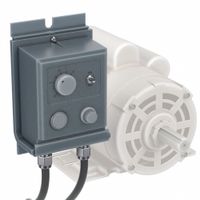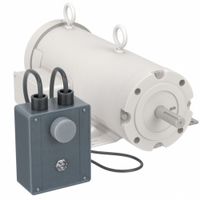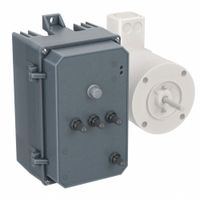Call +(254) 703 030 000 / 751 483 999 / 721 704 777
.....Read More
Frequently Asked Questions
What is a variable frequency drive (VFD) and how does it work?
A Variable Frequency Drive (VFD) is an electronic device used to control the speed and torque of an electric motor by varying the frequency and voltage of its power supply. It is commonly used in applications requiring precise motor control, energy savings, and process optimization.
A VFD operates by first converting the incoming AC power to DC using a rectifier. This DC power is then smoothed by a DC bus, which typically includes capacitors to reduce voltage ripple. The DC power is then converted back to AC using an inverter, which consists of power transistors or IGBTs (Insulated Gate Bipolar Transistors). The inverter adjusts the frequency and voltage of the output AC power, thus controlling the motor speed.
The VFD's control system uses Pulse Width Modulation (PWM) to create a variable output frequency. By adjusting the width of the pulses, the VFD can simulate a sinusoidal AC waveform, allowing precise control over the motor's speed and torque. The VFD can also provide soft start and stop functions, reducing mechanical stress on the motor and connected equipment.
VFDs offer several benefits, including energy savings by matching motor speed to load requirements, reduced mechanical wear, and improved process control. They are widely used in industries such as HVAC, manufacturing, and water treatment, where motor speed control is essential for efficiency and performance.
How do you select the right motor drive for an application?
To select the right motor drive for an application, consider the following factors:
1. **Load Requirements**: Determine the type of load (constant, variable, or shock) and its characteristics, such as torque, speed, and power. This helps in choosing a drive that can handle the load efficiently.
2. **Motor Type**: Identify the type of motor (AC, DC, servo, or stepper) that suits the application. Each motor type has specific drive requirements.
3. **Power Supply**: Ensure the drive is compatible with the available power supply in terms of voltage, phase, and frequency.
4. **Control Requirements**: Decide on the level of control needed, such as speed, torque, or position control. Drives offer different control methods like V/f control, vector control, or direct torque control.
5. **Environmental Conditions**: Consider the operating environment, including temperature, humidity, and exposure to dust or chemicals. Select a drive with appropriate protection ratings (IP ratings).
6. **Efficiency and Energy Savings**: Evaluate the drive's efficiency and potential for energy savings, especially for applications with variable loads.
7. **Size and Space Constraints**: Ensure the drive fits within the physical space available in the application setup.
8. **Communication and Integration**: Check for compatibility with existing control systems and communication protocols (e.g., Modbus, Ethernet/IP).
9. **Safety and Compliance**: Ensure the drive meets relevant safety standards and certifications for the application and region.
10. **Cost and Budget**: Balance the initial cost with long-term benefits like energy savings, maintenance, and reliability.
11. **Vendor Support and Service**: Consider the availability of technical support, service, and warranty from the manufacturer.
By evaluating these factors, you can select a motor drive that meets the specific needs of your application, ensuring optimal performance and reliability.
What are the benefits of using a VFD in motor applications?
A Variable Frequency Drive (VFD) offers numerous benefits in motor applications:
1. **Energy Efficiency**: VFDs adjust the motor speed to match the load requirements, reducing energy consumption significantly, especially in applications like fans and pumps where the power required is proportional to the cube of the speed.
2. **Process Control**: They provide precise control over motor speed and torque, enhancing process control and improving product quality in manufacturing processes.
3. **Reduced Mechanical Stress**: By allowing soft starts and stops, VFDs minimize mechanical stress on motors and connected equipment, reducing wear and tear and extending equipment lifespan.
4. **Lower Maintenance Costs**: The reduced mechanical stress and improved control lead to lower maintenance requirements and costs over time.
5. **Improved System Performance**: VFDs can optimize the performance of systems by adjusting motor speed to match the exact needs of the application, improving overall system efficiency.
6. **Power Factor Improvement**: VFDs can improve the power factor of the system, reducing the reactive power demand and potentially lowering electricity costs.
7. **Reduced Inrush Current**: They limit the inrush current during motor start-up, reducing the risk of electrical issues and improving the stability of the power supply.
8. **Flexibility and Adaptability**: VFDs allow for easy changes in motor speed and direction, providing flexibility in operations and the ability to adapt to changing process requirements.
9. **Environmental Benefits**: By reducing energy consumption and improving efficiency, VFDs contribute to lower greenhouse gas emissions and a smaller carbon footprint.
10. **Enhanced Safety**: VFDs can incorporate safety features such as overload protection, fault diagnostics, and emergency stop functions, enhancing the safety of motor operations.
How do you connect a VFD to a motor and power supply?
To connect a Variable Frequency Drive (VFD) to a motor and power supply, follow these steps:
1. **Safety First**: Ensure all power sources are turned off. Use lockout/tagout procedures to prevent accidental power-up.
2. **VFD Placement**: Mount the VFD in a well-ventilated area to prevent overheating. Ensure it is protected from dust, moisture, and vibration.
3. **Power Supply Connection**:
- Identify the input terminals on the VFD, usually labeled L1, L2, and L3 for three-phase power, or L and N for single-phase.
- Connect the power supply cables to these terminals. Ensure the power supply voltage matches the VFD's input voltage rating.
4. **Motor Connection**:
- Identify the output terminals on the VFD, typically labeled T1, T2, and T3.
- Connect the motor leads to these terminals. Ensure the motor voltage and current ratings are compatible with the VFD's output.
5. **Grounding**:
- Connect the VFD's ground terminal to the system ground. This is crucial for safety and to prevent electrical noise.
- Ground the motor frame to the same ground point.
6. **Control Wiring**:
- Connect any control wiring as per the VFD's manual. This may include start/stop commands, speed reference signals, or communication interfaces.
7. **Parameter Configuration**:
- Power on the VFD and configure its parameters according to the motor's specifications, such as voltage, current, frequency, and acceleration/deceleration times.
8. **Testing**:
- Perform a test run without load to ensure the motor operates correctly. Check for correct rotation direction and adjust if necessary.
9. **Final Checks**:
- Inspect all connections for tightness and ensure there are no exposed wires. Confirm that all safety covers are in place.
10. **Operation**:
- Once verified, the system can be put into regular operation. Monitor for any unusual noises or vibrations.
What is the difference between a soft starter and a VFD?
A soft starter and a Variable Frequency Drive (VFD) are both used to control the starting and stopping of electric motors, but they operate differently and serve distinct purposes.
A soft starter is designed to reduce the inrush current and torque during the startup of an electric motor. It achieves this by gradually increasing the voltage to the motor, allowing it to accelerate smoothly to full speed. This reduces mechanical stress on the motor and the electrical stress on the power supply network. Soft starters are typically used in applications where the motor only needs to run at full speed and where the primary concern is reducing the impact of startup on the electrical and mechanical systems.
In contrast, a VFD controls both the voltage and frequency supplied to the motor, allowing for precise control over the motor's speed and torque throughout its operation. This makes VFDs suitable for applications requiring variable speed control, energy savings, and improved process control. VFDs can also provide soft starting capabilities, but their primary advantage is the ability to adjust motor speed to match the load requirements, leading to significant energy savings and enhanced process efficiency.
In summary, the main difference lies in their functionality: soft starters are used for smooth motor startup, while VFDs offer comprehensive speed and torque control throughout the motor's operation. Soft starters are simpler and less expensive, making them ideal for applications where only soft starting is needed. VFDs, being more complex and costly, are chosen for applications requiring variable speed control and energy efficiency.
How do you troubleshoot common issues with motor drives?
To troubleshoot common issues with motor drives, follow these steps:
1. **Visual Inspection**: Check for physical damage, loose connections, or burnt components. Ensure the drive is clean and free from dust or debris.
2. **Check Power Supply**: Verify that the drive is receiving the correct voltage and current. Use a multimeter to measure input power and ensure it matches the drive's specifications.
3. **Examine Fault Codes**: Most drives have a display or interface that shows fault codes. Refer to the drive's manual to interpret these codes and identify the issue.
4. **Inspect Wiring and Connections**: Ensure all wiring is correct and secure. Check for signs of wear or damage in cables and connectors.
5. **Test Motor and Load**: Disconnect the motor from the drive and test it separately to ensure it operates correctly. Check for mechanical issues like misalignment or excessive load.
6. **Parameter Settings**: Review the drive's parameter settings to ensure they are configured correctly for the application. Incorrect settings can lead to performance issues.
7. **Check for Overheating**: Ensure the drive is not overheating. Check cooling fans and heat sinks for proper operation and cleanliness.
8. **Monitor Environmental Conditions**: Ensure the drive is operating within its specified environmental conditions, such as temperature and humidity.
9. **Firmware and Software Updates**: Ensure the drive's firmware and any associated software are up to date. Manufacturers often release updates to fix known issues.
10. **Consult Documentation and Support**: Refer to the drive's manual for troubleshooting tips. If issues persist, contact the manufacturer's technical support for assistance.
By systematically following these steps, you can identify and resolve common issues with motor drives effectively.
What are the energy savings associated with using VFDs?
Variable Frequency Drives (VFDs) offer significant energy savings by optimizing motor speed and torque to match the actual load requirements. Traditional motors often run at full speed regardless of demand, leading to energy wastage. VFDs adjust the motor speed to the precise needs of the application, reducing energy consumption.
1. **Reduced Power Consumption**: VFDs decrease the power required by controlling the motor speed. The power consumption of a motor is proportional to the cube of its speed. Therefore, even a small reduction in speed can lead to substantial energy savings.
2. **Improved Process Control**: By providing precise control over motor speed, VFDs enhance process efficiency and reduce energy usage. This is particularly beneficial in applications like pumps, fans, and compressors, where demand can vary significantly.
3. **Lower Demand Charges**: VFDs can reduce peak demand charges by minimizing the inrush current during motor startup. Soft starting capabilities prevent the motor from drawing excessive current, which can lead to lower utility demand charges.
4. **Decreased Mechanical Stress**: VFDs reduce mechanical stress on motors and equipment by providing smooth acceleration and deceleration. This not only extends the lifespan of the equipment but also reduces maintenance costs and downtime, indirectly contributing to energy savings.
5. **Enhanced System Efficiency**: In systems with fluctuating loads, VFDs maintain optimal efficiency by adjusting motor speed to match the load, preventing energy loss associated with throttling or bypass methods.
Overall, the energy savings from VFDs can range from 20% to 50% depending on the application and load profile. These savings contribute to lower operational costs and a reduced carbon footprint, making VFDs a sustainable choice for energy management.
How do you program and configure a VFD for specific applications?
To program and configure a Variable Frequency Drive (VFD) for specific applications, follow these steps:
1. **Understand the Application Requirements**: Determine the motor specifications, load characteristics, and operational requirements such as speed range, torque, and control method (e.g., constant torque, variable torque).
2. **Select the Appropriate VFD**: Choose a VFD that matches the motor's voltage, current, and power ratings. Ensure it supports the required control methods and has necessary features like overload protection, braking, and communication interfaces.
3. **Installation**: Properly install the VFD according to the manufacturer's guidelines. Ensure correct wiring of power supply, motor connections, and control signals. Use appropriate fuses and circuit breakers for protection.
4. **Initial Setup**: Power up the VFD and access the user interface, typically via a keypad or software. Set basic parameters such as motor voltage, current, frequency, and acceleration/deceleration times.
5. **Motor Data Input**: Enter motor nameplate data into the VFD, including rated voltage, current, frequency, and speed. This ensures the VFD can accurately control the motor.
6. **Control Method Configuration**: Select the control method (e.g., V/Hz, sensorless vector, or closed-loop vector control) based on application needs. Configure related parameters for optimal performance.
7. **Speed and Torque Settings**: Set minimum and maximum speed limits, torque limits, and any required speed profiles. Adjust slip compensation and torque boost settings if necessary.
8. **Protection and Safety**: Configure protection settings such as overcurrent, overvoltage, and thermal protection. Set fault handling procedures and alarms.
9. **Testing and Tuning**: Run the motor in a controlled environment to test the configuration. Fine-tune parameters for smooth operation, efficiency, and performance.
10. **Documentation and Maintenance**: Document the configuration settings and maintain a log for future reference. Schedule regular maintenance checks to ensure continued optimal performance.
What safety precautions should be taken when working with motor drives?
1. **Personal Protective Equipment (PPE):** Wear appropriate PPE such as safety glasses, insulated gloves, and protective footwear to prevent electrical shocks and injuries.
2. **Lockout/Tagout (LOTO):** Implement LOTO procedures to ensure that the motor drive is de-energized and cannot be accidentally started during maintenance or repair.
3. **Training and Competency:** Ensure that personnel working with motor drives are adequately trained and understand the specific equipment and safety protocols.
4. **Proper Tools and Equipment:** Use insulated tools and equipment designed for electrical work to minimize the risk of electric shock.
5. **Environment Safety:** Ensure the work area is dry and free from conductive materials. Avoid working in wet or damp conditions to prevent electrical hazards.
6. **Voltage Verification:** Use a multimeter or voltage tester to verify that the motor drive is de-energized before beginning work.
7. **Clear Signage and Warnings:** Post clear warning signs and labels on and around motor drives to alert personnel of potential hazards.
8. **Emergency Procedures:** Be familiar with emergency shutdown procedures and have a clear plan in place for responding to accidents or electrical faults.
9. **Regular Maintenance and Inspection:** Conduct regular inspections and maintenance of motor drives to identify and rectify potential issues before they become hazardous.
10. **Static Discharge Precautions:** Use grounding straps and other anti-static measures to prevent static discharge, which can damage sensitive components.
11. **Proper Ventilation:** Ensure adequate ventilation to prevent overheating and accumulation of hazardous fumes.
12. **Follow Manufacturer Guidelines:** Adhere to the manufacturer’s instructions and safety guidelines for installation, operation, and maintenance of motor drives.
13. **Avoid Loose Clothing and Jewelry:** Remove loose clothing and jewelry that could get caught in moving parts or conduct electricity.
14. **Communication:** Maintain clear communication among team members to ensure coordinated and safe operations.
How do you maintain and service motor drives and speed controls?
To maintain and service motor drives and speed controls, follow these steps:
1. **Regular Inspection**: Conduct routine visual inspections to check for signs of wear, overheating, or damage. Look for loose connections, burnt components, or unusual noises.
2. **Cleaning**: Keep the drive and its environment clean. Dust and debris can cause overheating and electrical faults. Use compressed air to remove dust from vents and components.
3. **Cooling System Maintenance**: Ensure that cooling fans and heat sinks are functioning properly. Clean or replace filters and ensure adequate ventilation to prevent overheating.
4. **Electrical Connections**: Tighten all electrical connections regularly to prevent arcing and ensure efficient power flow. Check for corrosion and clean contacts as necessary.
5. **Firmware and Software Updates**: Keep the drive’s firmware and any associated software up to date to ensure optimal performance and security.
6. **Parameter Settings**: Regularly review and adjust parameter settings to match the operational requirements. Incorrect settings can lead to inefficiencies or damage.
7. **Vibration Analysis**: Conduct vibration analysis to detect imbalances or misalignments in the motor, which can lead to premature wear or failure.
8. **Thermal Imaging**: Use thermal imaging to identify hot spots that may indicate electrical or mechanical issues.
9. **Lubrication**: Ensure that all moving parts are properly lubricated according to the manufacturer’s specifications to reduce friction and wear.
10. **Testing and Calibration**: Periodically test and calibrate the drive to ensure it operates within the desired specifications. Use diagnostic tools to check performance.
11. **Documentation**: Maintain detailed records of all maintenance activities, including inspections, repairs, and parts replacements, to track the drive’s history and anticipate future needs.
12. **Training**: Ensure that personnel are adequately trained in the operation and maintenance of motor drives and speed controls to prevent mishandling and ensure safety.




